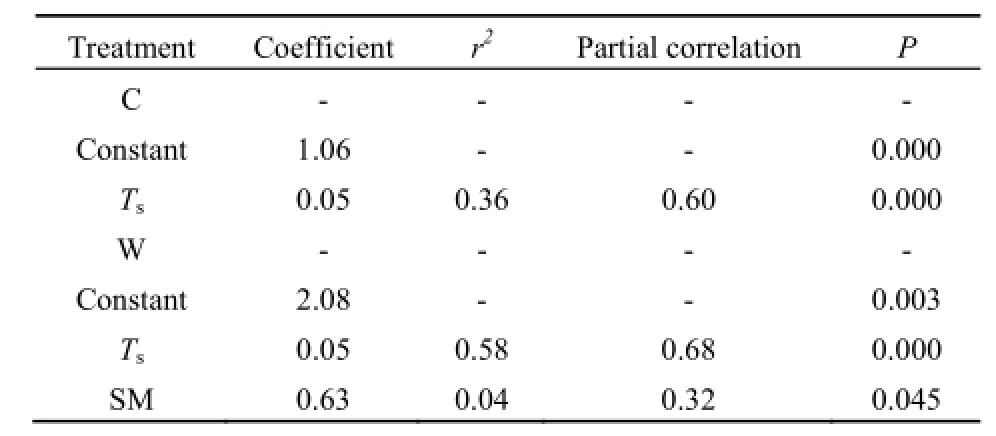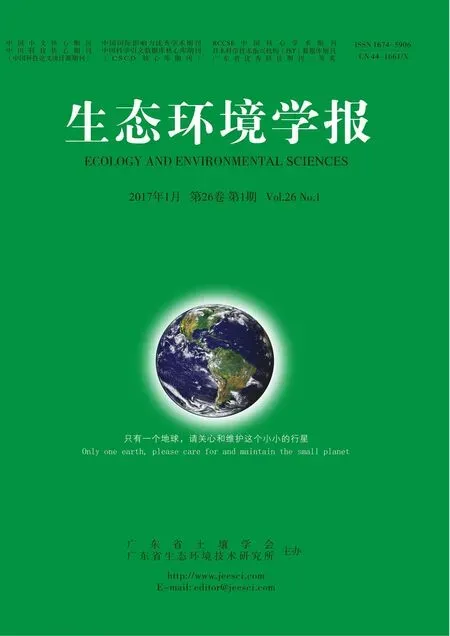实验增温对西藏高原玉米田土壤呼吸的影响
付刚,钟志明
中国科学院地理科学与资源研究所//生态系统网络观测与模拟重点实验室//拉萨高原生态系统研究站,北京 100101
实验增温对西藏高原玉米田土壤呼吸的影响
付刚,钟志明*
中国科学院地理科学与资源研究所//生态系统网络观测与模拟重点实验室//拉萨高原生态系统研究站,北京 100101
青藏高原农业区正经历着明显的气候变暖,但气候变暖如何影响高寒农业生态系统碳循环目前仍不明确。土壤呼吸是第二大陆地生态系统碳通量,高寒农业生态系统土壤呼吸对气候变暖的响应的不确定性限制了气候变化背景下人类对青藏高原高寒生态系统碳循环的预测能力。2015年4月在西藏玉米田采用开顶式生长箱进行模拟增温试验,旨在探究气候变暖对土壤呼吸及其温度敏感性的影响。在2015年玉米生长季节的5—8月份,利用Li8100土壤通量观测系统测定了6次土壤呼吸日变化(8:00—20:00),并利用HOBO微气候观测系统观测了5 cm深处的土壤温度和土壤湿度。结果表明,实验增温显著提高了5 cm深处的土壤温度(t=11.93,P=0.000),增幅为3.22 ℃,同时显著降低了5 cm深处的土壤含水量,降幅为0.04 m3·m-3(t=4.87,P=0.008)。对照和模拟增温处理的土壤呼吸速率分别为6.79 µmol·m-2·s-1和7.34 µmol·m-2·s-1,两者间无显著差异(F=1.65,P=0.235)。尽管如此,土壤呼吸仍存在着显著的日变化(F=137.66,P=0.000)和季节变异(F=54.48,P=0.000)。对照和模拟增温处理的土壤呼吸温度敏感性分别为1.70和1.77,两者间也无显著差异(t=2.69,P=0.100)。土壤温度解释了36%的对照处理的土壤呼吸变异,而土壤温度和土壤湿度共同解释了62%的土壤呼吸变异。因此,3.22 ℃的土壤增温没有显著改变土壤呼吸及其温度敏感性,这与3.22 ℃的土壤增温引起了土壤湿度的降低有关。
被动增温;土壤含水量;温度敏感性;青藏高原
土壤呼吸(soil respiration,Rs)是全球第二大陆地生态系统碳通量,仅小于植被光合作用(Raich et al.,1995)。土壤呼吸的一个极小的变化都可能影响全球碳平衡(Cox et al.,2000;Peng et al.,2015a)。就排放到大气中的CO2而言,农业土壤是重要的贡献者,在全球碳循环中扮演着重要角色。与森林和草地生态系统相比,农业土壤富含土壤有机质,土壤水分条件较好以及通气状况良好,农业土壤对气候变化可能有更强的响应(Lal,2004)。在1995—2004年,中国农业生态系统的土壤呼吸大约占全中国陆地生态系统土壤呼吸的22.2%,且农田的土壤呼吸温度敏感性大于草地(Yu et al.,2010)。与全中国其他地区相比,有关青藏高原农田生态系统对气候变化的响应实验研究很少(Zhong et al.,2016)1-8,而高寒农田是农田生态系统的重要组成部分。因此,准确定量化青藏高原高寒农田生态系统土壤呼吸对气候变化的响应对理解全球气候变化和预测大气CO2浓度变化意义重大(Liang et al.,2004)。
青藏高原的农业区主要位于半干旱的河谷区域(Yang et al.,1996),由于海拔高(3000~4500 m)和温度低,这些地区是典型的高寒农业区(Zhang et al.,2000)。由于青藏高原具有高寒和干燥的特点,其农业生态系统非常脆弱,且其农业区正经历着明显的气候变暖(Shen et al.,2014)。原位控制增温实验能够为全球气候变化研究提供一定的理论基础和数据支持,然而,目前在青藏高原农业区开展原位控制增温的实验研究还很少见(付刚等,2016)1093。有关青藏高原农田生态系统土壤呼吸对原位控制增温的响应研究也只限于西藏青稞Highland barley农田土壤呼吸的初始响应(Zhong et al.,2016)1-8。虽然针对青稞农田的研究表明模拟增温并没有显著改变青稞农田土壤呼吸及其温度敏感性(Zhong et al.,2016)1,但是前人的很多研究均表明模拟增温显著改变了青藏高原高寒草地和森林生态系统的土壤呼吸(Lin et al.,2011;Xu et al.,2010)。有关青藏高原的整合分析也表明,增温将显著促进土壤呼吸(Zhang et al.,2015)。此外,前人的一些研究表明,模拟增温显著促进了温带和亚热带农田生态系统的土壤呼吸(Liu et al.,2012;Reth et al.,2009)。然而,气候变暖如何影响青藏高原农业生态系统土壤呼吸目前仍不清楚,需要增加更多的有关模拟增温对青藏高原农田生态系统土壤呼吸的影响研究。
定量化玉米生态系统对气候变化的响应在定量化气候变化如何影响全球农业生态系统中扮演着重要角色。作为一种适应性强的农作物,玉米在西藏自治区也有种植,2009年的种植面积为4020 hm2(分别占同期粮食作物和农作物总播种面积的2.4%和1.7%)(李玲等,2014;李勇等,2014)。目前有关玉米田对原位控制增温的实验研究只分析了玉米物候和生物量与增温的关系(付刚等,2016)1093,而缺少土壤呼吸对增温的响应研究。因此,本研究基于西藏自治区拉萨市达孜县农业生态实验站玉米田模拟增温实验平台,分析了土壤呼吸及其温度敏感性对增温的响应。基于前人的研究(Zhong et al.,2016)1,本研究假设增温不会显著促进土壤呼吸,同时也不会显著降低土壤呼吸温度敏感性。
1 材料与方法
1.1 研究地概况与实验设计
本研究区域(91°21'E,29°41'N,海拔3688 m)位于西藏自治区拉萨市农业生态试验站。年平均温度7.9 ℃,年均降水量425 mm,90%的降水集中于6—9月(Zhong et al.,2016)2。自20世纪70年代开始试验区土壤被用于农作物种植。试验共设置两个增温处理(对照:C;增温3.22 ℃:W),每个处理3次重复。2015年4月22日在试验地布设了开顶式生长箱。开顶式生长箱高2.10 m,宽2.00 m,长3 m。每个小区间隔约为5~6 m。2015年4月22日播种玉米,9月19日收割,行间距约20 cm。
1.2 土壤温度和土壤含水量监测
在每个小区中间设置1套微气候观测系统(HOBO weather station,Onset Computer,Bourne,MA,USA),用于监测5 cm深处的土壤温度(soil temperature,Ts)和土壤湿度(soil moisture,SM)。
1.3 土壤呼吸测定
于2015年玉米生长季节的5—8月,利用带有半径为20 cm的不透明的调查室的开路式碳通量观测系统(LI-8100,LI-COR Biosciences,Lincoln,NE,USA)测定土壤呼吸(Zhong et al.,2016)3,每月测定2次(非生长季未进行观测)。2015年5月,将半径为20 cm、高5 cm的PVC环打入每个样方的中间位置土壤约2~3 cm深处。由于PVC环位于两行玉米之间,所以PVC环内并不包括玉米地上部分。分别于5月25日、6月16日、7月3日、7月18日、8月1日、8月31日测定土壤呼吸的日变化(8:00—20:00),每2小时测定1次。在测量土壤呼吸的前1天将土壤环内的杂草齐地面刈割,并将刈割掉的杂草地上部分取走,以排除杂草地上部分呼吸。
1.4 统计分析
对于每一个处理,首先将Rs和SM取对数,然后利用多重逐步回归分析分析Rs和Ts、SM的关系。根据Rs=aebTs分析每一个处理Rs的温度敏感性,a表示当Ts=0时Rs的值,b能反映Rs温度敏感性(Q10)(Shen et al.,2015)。采用重复测量方差分析对土壤呼吸进行了相关统计分析,所有的统计分析都通过SPSS(Version 16.0;SPSS Inc.,Chicago,IL)完成。
2 结果和讨论
实验增温显著提高了土壤温度(t=11.93,P=0.000),增幅为3.22 ℃,增温显著降低了土壤湿度(t=4.87,P=0.008),降幅为18.0%(-0.04 m3·m-3)(图1)。实验增温对土壤湿度的负效应与以往的野外增温观测结果一致(Allison et al.,2008;Arnold et al.,1999;Hartley et al.,2007;Poll et al.,2013)。Xu et al.(2013)和Bai et al.(2013)通过整合分析,分别发现实验增温降低了9.25%和4.1%的农业生态系统的土壤湿度。实验增温引起的土壤湿度的降低与实验增温增强了土壤蒸散有关(Peng et al.,2015b)。
虽然对照和增温处理间的Rs差异极小(平均土壤呼吸速率分别为6.79 µmol·m-2·s-1和7.34 µmol·m-2·s-1),但是Rs的季节变化和日变化较大(表1,图2)。同样的现象也发生在藏北高寒草甸(Shen et al.,2016)、西藏青稞农田(Zhong et al.,2016)4、温带农业系统(Hou et al.,2014)和半干旱温带森林草原生态系统(Lellei-kovcs et al.,2008)。

表1 土壤呼吸重复测量方差分析Table 1 Repeated measures ANOVA for the main and interactive effects of experimental warming (W), measuring date (D) and time (T) on soilrespiration (Rs, µmol·m-2·s-1) in a maize system ofTibet

图1 西藏玉米田(a)土壤温度和(b)土壤含水量对实验增温的响应。Fig. 1 Response of (a) soil temperature (Ts) and (b) soil moisture (SM) to experimental warming in a maize system of the Tibet

图2 2015年(a)5月25日;(b)6月16日;(c)7月3日;(d)7月18日;(e)8月1日和(f)8月31日西藏玉米田土壤呼吸对实验增温的响应Fig. 2 Response of soil respiration (Rs) to experimental warming in a maize system of the Tibet in (a) May 25; (b) June 16; (c) July 3; (d) July 18; (e) August 1 and (f) August 31 of 2015
土壤呼吸随着土壤温度的增加而显著增强(图3)。实验增温对Q10无显著影响(对照:1.70;增温:1.77)(t=2.69,P=0.100)。增温导致Rs的变化量与SM的变化量呈显著正相关关系(图4),这与西藏青稞田的研究结果一致(Zhong et al.,2016)7。Ts和SM共同解释了增温处理的Rs变异,而Ts单独解释了对照的Rs变异(表2)。这些研究表明增温导致的土壤干旱削弱甚至掩盖了土壤温度的增加对Rs的正效应(Shen et al.,2015)。
前人的相关研究表明青藏高原高寒生态系统Rs对气候变暖并不总是表现为正响应(Shen et al.,2015;Zhong et al.,20161),本研究中增温对Rs和Q10的不显著影响也验证了这一结论,这很可能与增温导致的土壤干旱有关。这种现象也发生在农田系统(Poll et al.,2013;Wall et al.,2013)、草地系统(Liu et al.,2009;Wan et al.,2007)和半干旱温带森林草原生态系统(Lellei-kovcs et al.,2008)。
3 结论
总体而言,3.22 ℃的土壤温度升高没有显著影响西藏玉米田的土壤呼吸及其温度敏感性,这与土壤增温导致的土壤湿度的降低有关。在降水保持不变的情况下,增温会造成土壤干旱;而灌溉可缓解甚至弥补土壤干旱对土壤呼吸的负影响,导致玉米田土壤向大气排放更多的CO2,从而加剧气候变暖。因此,就土壤呼吸对气候变暖的响应而言,即使在有灌溉条件的地区也不宜过度灌溉。

图4 增温导致的土壤呼吸的变化量与土壤含水量的变化量的关系Fig. 4 Relationship between the change of soil respiration (ΔRs) and the change of soil moisture (ΔSM) caused by experimental warming

表2 土壤呼吸与土壤温度、土壤湿度的多重逐步回归分析Table 2 Stepwise multiple regression analyses between soil respiration (Rs) and soil temperature (Ts) and soil moisture (SM), showing regression coefficient, coefficient of determination (r2) , partial correlation coefficient and significance probability (P)
ALLISON S D, TRESEDER K K. 2008. Warming and drying suppress microbial activity and carbon cycling in boreal forest soils [J]. Global Change Biology, 14(12): 2898-2909.图3 (a)对照和(b)增温处理的土壤呼吸与土壤温度的关系Fig. 3 Relationship between soil respiration (Rs) and soil temperature (Ts) for (a) the control and (b) experimental warming treatments
ARNOLD S S, FERNANDEZ I J, RUSTAD L E, et al. 1999. Microbial response of an acid forest soil to experimental soil warming [J]. Biology and Fertility of Soils, 30(3): 239-244.
BAI E, LI S L, XU W H, et al. 2013. A meta-analysis of experimental warming effects on terrestrial nitrogen pools and dynamics [J]. New Phytologist, 199(2): 441-451.
COX P M, BETTS R A, JONES C D, et al. 2000. Acceleration of global warming due to carbon-cycle feedbacks in a coupled climate model [J]. Nature, 408 (6809): 184-187.
HARTLEY I P, HEINEMEYER A, EVANS S P, et al. 2007. The effect of soil warming on bulk soil vs. rhizosphere respiration [J]. Global Change Biology, 13(12): 2654-2667.
HOUR R X, OUYANG Z, WILSON G V, et al. 2014. Response of carbon dioxide emissions to warming under no-Till and conventional till systems [J]. Soil Science Society of America Journal, 78(1): 280-289.
LAL R. 2004. Soil carbon sequestration impacts on global climate change and food security [J]. Science, 304(5677): 1623-1627.
LELLEI-KOVCS E, KOVACS-LANG E, KALAPOS T, et al. 2008. Experimental warming does not enhance soil respiration in a semiarid temperate forest-steppe ecosystem [J]. Community Ecology, 9(1): 29-37. LIANG N S, NAKADAI T, HIRANO T, et al. 2004. In situ comparison of four approaches to estimating soil CO2 efflux in a northern larch (Larix kaempferi Sarg.) forest [J]. Agricultural and Forest Meteorology, 123(1-2): 97-117.
LIN X W, ZHANG Z H, WANG S P, et al. 2011. Response of ecosystem respiration to warming and grazing during the growing seasons in the alpine meadow on the Tibetan plateau [J]. Agricultural and Forest Meteorology, 151(7): 792-802.
LIU W X, ZHANG Z, WAN S Q. 2009. Predominant role of water in regulating soil and microbial respiration and their responses to climate change in a semiarid grassland [J]. Global Change Biology, 15(1): 184-195.
LIU Y, CHEN S T, HU Z H, et al. 2012. Effects of simulated warming on soil respiration in a cropland under winter wheat-soybean rotation (in Chinese with English abstract) [J]. Environmental Science, 33(12): 4205-4211.
PENG F, XU M H, YOU Q G, et al. 2015a. Different responses of soil respiration and its components to experimental warming with contrasting soil water content [J]. Arctic Antarctic and Alpine Research, 47(2): 359-368.
PENG F, YOU Q G, XUE X, et al. 2015b. Evapotranspiration and its source components change under experimental warming in alpine meadow ecosystem on the Qinghai-Tibet plateau [J]. Ecological Engineering, 84: 653-659.
POLL C, MARHAN S, BACK F, et al. 2013. Field-scale manipulation of soil temperature and precipitation change soil CO2flux in a temperate agricultural ecosystem [J]. Agriculture Ecosystems & Environment, 165: 88-97.
RAICH J W, POTTER C S. 1995. Global patterns of carbon dioxide emissions from soils [J]. Global Biogeochemical Cycles, 9(1): 23-36.
RETH S, GRAF W, REICHSTEIN M, et al. 2009. Sustained stimulation of soil respiration after 10 years of experimental warming [J]. Environmental Research Letters, DOI: 10.1088/1748-9326/1084/ 1082/024005.
SHEN Z X, FU G, YU C Q, et al. 2014. Relationship between the growing season maximum enhanced vegetation index and climatic factors on the Tibetan Plateau [J]. Remote Sensing, 6(8): 6765-6789.
SHEN Z X, LI Y L, FU G. 2015. Response of soil respiration to short-term experimental warming and precipitation pulses over the growing season in an alpine meadow on the Northern Tibet [J]. Applied Soil Ecology, 90: 35-40.
SHEN Z X, WANG J W, SUN W, et al. 2016. The soil drying along the increase of warming mask the relation between temperature and soil respiration in an alpine meadow of Northern Tibet [J]. Polish Journal of Ecology, 64(1): 125-129.
WALL G W, MCLAIN J E T, KIMBALL B A, et al. 2013. Infrared warming affects intrarow soil carbon dioxide efflux during vegetative growth of spring wheat [J]. Agronomy Journal, 105(3): 607-618.
WAN S, NORBY R J, LEDFORD J, et al. 2007. Responses of soil respiration to elevated CO2, air warming, and changing soil water availability in a model old-field grassland [J]. Global Change Biology, 13(11): 2411-2424.
XU W F, YUAN W P, DONG W J, et al. 2013. A meta-analysis of the response of soil moisture to experimental warming [J]. Environmental Research Letters, DOI: 10.1088/1748-9326/1088/1084/044027.
XU Z F, Wan C A, XIONG P, et al. 2010. Initial responses of soil CO2efflux and C, N pools to experimental warming in two contrasting forest ecosystems, Eastern Tibetan Plateau, China [J]. Plant and Soil, 336(1-2): 183-195.
YANG G H, DU E S, XU Z Y, et al. 1996. Productivity of land resources and population carrying capacity in Xizang [J]. Lhasa: Tibetan People’s Publishing House: 44-72.
YU G, ZHENG Z, WANG Q, et al. 2010. Spatiotemporal pattern of soil respiration of terrestrial ecosystems in China: the development of a geostatistical model and its simulation [J]. Environmental Science & Technology, 44(16): 6074-6080.
ZHANG X Z, SHEN Z X, FU G. 2015. A meta-analysis of the effects of experimental warming on soil carbon and nitrogen dynamics on the Tibetan Plateau [J]. Applied Soil Ecology, 87: 32-38.
ZHANG X Z, ZHANG Y G, ZHOUB Y H. 2000. Measuring and modelling photosynthetically active radiation in Tibet Plateau during April-October [J]. Agricultural and Forest Meteorology, 102(2-3): 207-212.
ZHONG Z M, SHEN Z X, FU G. 2016. Response of soil respiration to experimental warming in a highland barley of the Tibet [J]. SpringerPlus, DOI: 10.1186/s40064-40016-41761-40060.
付刚, 钟志明. 2016. 西藏高原玉米物候和生态特征对增温响应的模拟试验研究[J]. 生态环境学报, 25(7): 1093-1097.
李玲, 许立红, 高丽萍, 等. 2014. 兰州市鲜食玉米栽培技术[J]. 甘肃农业科技, (1): 59-60.
李勇, 何云芬. 2014. 高海拔地区玉米栽培技术[J]. 南方农业, 8(21): 33-33.
Effect of Experimental Warming on Soil Respiration in A Maize System of Tibet
FU Gang, ZHONG Zhiming
Lhasa Plateau Ecosystem Research Station, Key Laboratory of Ecosystem Network Observation and Modeling,
Institute of Geographic Sciences and Natural Resources Research, Chinese Academy of Sciences, Beijing 100101, China
The agricultural regions on the Tibetan Plateau are experiencing obvious climatic warming, while how climatic warming will affect carbon cycling in agricultural ecosystems remains unclear. Soil respiration is the second largest carbon flux in terrestrial ecosystems. Uncertainties about the response of soil respiration in alpine croplands to climatic warming limits our ability to predict carbon cycling in alpine ecosystems on the Tibetan Plateau under future climatic change. A field warming experiment was conducted in a maize system of the Tibet in April 2015 and the objective of this study was to investigate the effect of experimental warming on soil respiration and its temperature sensitivity. Six diurnal variations of soil respiration were measured using LI8100 soil carbon flux measurement system during the period from May to August in 2015. Soil temperature and soil moisture at depth of 5 cm were also measured using HOBO microclimate measurement system. Experimental warming increased significantly soil temperature by 3.22 ℃ (t=11.93, P=0.000), but decreased significantly soil moisture by 0.04 m3·m-3(t=4.87, P=0.008). Soil respiration under control and warming conditions was 6.79 µmol·m-2·s-1and 7.34 µmol·m-2·s-1, respectively, and there was no significant difference of soil respiration between control and warming treatments (F=1.65, P=0.235). However, there was significant diurnal variation (F=137.66, P=0.000) and seasonal variation (F=54.48, P=0.000) of soil respiration. Experimental warming did not affect temperature sensitivity of soil respiration (t=2.69, P=0.100) and temperature sensitivity of soil respiration in control and warming treatments was 1.70 and 1.77, respectively. Soil temperature explained 36% variation of soil respiration in control plots, while soil temperature and soil moisture together explained 62% variation of soil respiration. Therefore, 3.22 ℃ increase in soil temperature did not affect soil respiration and its temperature sensitivity, which was correlated with the decline in soil moisture caused by experimental warming.
passive warming; soil moisture; temperature sensitivity; Tibetan Plateau
10.16258/j.cnki.1674-5906.2017.01.008
X16; S154.1
A
1674-5906(2017)01-0049-06
付刚, 钟志明. 2017. 实验增温对西藏高原玉米田土壤呼吸的影响[J]. 生态环境学报, 26(1): 49-54.
FU Gang, ZHONG Zhiming. 2017. Effect of experimental warming on soil respiration in a maize system of Tibet [J]. Ecology and Environmental Sciences, 26(1): 49-54.
国家自然科学基金项目(31370458;31600432);生态系统网络观测与模拟重点实验室青年创新研究团队项目(LENOM2016Q0002);中国科学院“西部之光人才计划”(藏北高原高寒草甸牲畜承载力对气候变化和放牧的响应);西藏自治区自然科学基金项目(西藏高寒草甸物种丰富度和地上生物量对增温的响应);西藏草业重大专项(2015ZDKJZC;2016ZDKJZC);国家科技支撑计划项目(2011BAC09B03);国家重点研发计划项目(2016YFC0502005;2016YFC0502006)
付刚(1984年生),男,副研究员,博士,研究方向为高寒生态系统与全球变化。E-mail: fugang@igsnrr.ac.cn
*通信作者
2016-09-11

